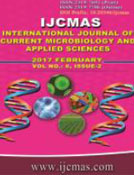


 National Academy of Agricultural Sciences (NAAS)
National Academy of Agricultural Sciences (NAAS)

|
PRINT ISSN : 2319-7692
Online ISSN : 2319-7706 Issues : 12 per year Publisher : Excellent Publishers Email : editorijcmas@gmail.com / submit@ijcmas.com Editor-in-chief: Dr.M.Prakash Index Copernicus ICV 2018: 95.39 NAAS RATING 2020: 5.38 |
The physiological responses, dry matter and water intake of Sahiwal and Karan Fries (Holstein-Friesian X Tharparkar) heifers were monitored under two feeding regimes i.e. feeding regime-1 (NRC, 2001) and feeding regime-2 (15 % higher energy than NRC 2001, by supplementation of molasses). Six each of healthy heifers of Sahiwal and Karan Fries (18-24 month) were selected from ICAR-National Dairy Research Institute (ICAR-NDRI), Karnal. Before start of actual experiment, the animals were given 15 days adaptation period on both the feeding regime. The physiological responses of Sahiwal and Karan Fries heifers was recorded on 1st, 7th, 14th, 15th and 16th day of each feeding regime after adaptation period. The feed offered to the animals and residue left were recorded on daily basis to find out dry matter intake (DMI) and water intake of all the experimental animals was recorded. The mean values of the physiological responses (RR, PR, RT and ST), DMI, and water intake were significantly (p<0.05) higher in Karan Fries than Sahiwal heifers maintained on both the feeding regimes. However rectal temperature (RT) was found significantly (p<0.05) higher at feeding regime-2 in both the breeds of heifers. The different proportion of acetate, propionate, and butyrate produced during invitro studies were found 70.27, 19.38, and 10.34 % for sorghum, 53.45, 37.77 and 8.78% for concentrate and 57.36, 32.98 and 9.64% for molasses. Based on the results of the study it can be stated that the feeding of 15% higher energy levels to dairy heifers readjusted their physiological mechanisms by increasing the physiological responses and propionate concentration during in-vitro studies.
 |
 |
 |
 |
 |